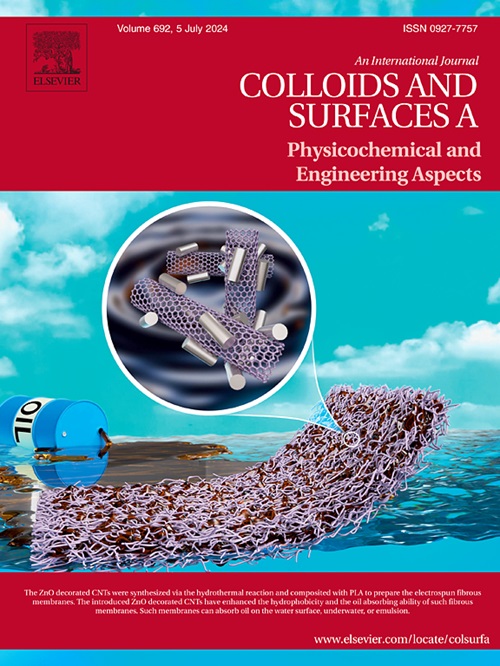NaCl-templated hierarchical porous carbons enhanced removal of tetracycline and ciprofloxacin: Mechanistic insights from site energy distribution and competitive adsorption
IF 5.4
2区 化学
Q2 CHEMISTRY, PHYSICAL
Colloids and Surfaces A: Physicochemical and Engineering Aspects
Pub Date : 2025-07-16
DOI:10.1016/j.colsurfa.2025.137758
引用次数: 0
Abstract
In this study, hollow spherical NaCl was successfully synthesized via crystal growth inhibition technology. Porous carbons were prepared using hollow spherical NaCl templates with varying dosages, and their adsorption capacities for tetracycline (TC) and ciprofloxacin (CIP) were systematically investigated. The microscopic morphology and specific surface area of the samples were thoroughly characterized using SEM and BET analysis. Kinetic analysis revealed that the adsorption processes of TC and CIP by the porous carbon conformed to pseudo-second-order kinetic and intraparticle diffusion models, indicating that the active site was the main factor affecting the adsorption process. Isothermal adsorption studies demonstrated that the Generalized Langmuir model provided a more accurate description of the adsorption behavior compared to the Langmuir model, indicating monolayer adsorption occurring at heterogeneous adsorption sites. Among the synthesized porous carbons, MCS-3 exhibited optimal adsorption performance, achieving adsorption capacities of 404 mg/g for TC and 268 mg/g for CIP. Site energy distribution analysis further confirmed that the adsorption sites on MCS-3 possessed a higher density of adsorption sites and elevated average site energy. Competitive adsorption experiments revealed stronger adsorption affinity of MCS-3 toward TC over CIP. XPS revealed the adsorption mechanism, and the results indicated that the adsorption between the porous carbon and TC/CIP mainly occurred through the synergistic effect of Lewis acid-base interactions and the hydrogen bonding network. Investigation of pH effects indicated that pH modulated adsorption efficiency by altering the surface charge of the porous carbon and the ionization states of TC/CIP. Recycling experiments demonstrated that MCS-3 maintained stable adsorption performance over five cycles, highlighting its excellent recyclability. These findings collectively provide a critical theoretical foundation and practical guidance for the application of porous carbon in the remediation of TC/CIP-contaminated systems.
nacl模板层状多孔碳增强了四环素和环丙沙星的去除:来自位点能量分布和竞争性吸附的机制见解
本研究通过晶体生长抑制技术成功合成了空心球形NaCl。采用不同用量的中空球形NaCl模板制备多孔碳,系统考察了其对四环素(TC)和环丙沙星(CIP)的吸附能力。利用SEM和BET分析对样品的微观形貌和比表面积进行了全面表征。动力学分析表明,多孔碳对TC和CIP的吸附过程符合准二级动力学和颗粒内扩散模型,表明活性位点是影响吸附过程的主要因素。等温吸附研究表明,与Langmuir模型相比,广义Langmuir模型提供了更准确的吸附行为描述,表明单层吸附发生在非均相吸附位点。在所合成的多孔碳中,MCS-3的吸附性能最佳,对TC的吸附量为404 mg/g,对CIP的吸附量为268 mg/g。位点能量分布分析进一步证实了MCS-3上的吸附位点具有较高的吸附位点密度和较高的平均位点能量。竞争吸附实验表明,MCS-3对TC的吸附亲和力高于CIP。XPS揭示了吸附机理,结果表明,多孔碳与TC/CIP之间的吸附主要是通过Lewis酸碱相互作用和氢键网络的协同作用发生的。pH的影响研究表明,pH通过改变多孔碳的表面电荷和TC/CIP的电离状态来调节吸附效率。回收实验表明,MCS-3在5个循环过程中保持稳定的吸附性能,表明其具有良好的可回收性。这些研究结果为多孔碳在TC/ cip污染体系修复中的应用提供了重要的理论基础和实践指导。
本文章由计算机程序翻译,如有差异,请以英文原文为准。
求助全文
约1分钟内获得全文
求助全文
来源期刊
CiteScore
8.70
自引率
9.60%
发文量
2421
审稿时长
56 days
期刊介绍:
Colloids and Surfaces A: Physicochemical and Engineering Aspects is an international journal devoted to the science underlying applications of colloids and interfacial phenomena.
The journal aims at publishing high quality research papers featuring new materials or new insights into the role of colloid and interface science in (for example) food, energy, minerals processing, pharmaceuticals or the environment.

 求助内容:
求助内容: 应助结果提醒方式:
应助结果提醒方式:


